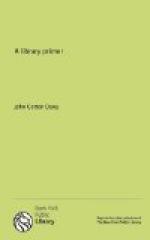800 Literature 810 American. 820 English. 830 German. 840 French. 850 Italian. 860 Spanish. 870 Latin. 880 Greek. 890 Minor Languages.
900 History 910 Geography and Description. 920 Biography. 930 Ancient History. 940 Europe. } 950 Asia. } 960 Africa. } Modern 970 North America. } 980 South America. } 990 Oceanica and Polar Regions.
CHAPTER XXII
The Expansive classification: C.A. Cutter’s
The classification
Those who have used it call it common-sense and up-to-date. They say that it is clear and easy to apply, and that it gives a suitable place for many classes of books for which other systems make no provision, or provide badly. It has been maturing for 20 years. Before it was printed it was applied (with a different notation) to the arrangement of a library of over 150,000 v. The experience thus gained has been supplemented as each part was prepared for the press by searching catalogs, bibliographies, and treatises on the subject classified. This ensured fullness. Overclassification, on the other hand, has been guarded against in four ways: 1) By not introducing at all distinctions that are purely theoretical or very difficult to apply; 2) by printing in small type those divisions which are worth making only when a large number of books calls for much subdivision; 3) by warning classifiers in the notes that certain divisions are needed only in large libraries; 4) by printing separately seven classifications of progressive fullness, the first having only 11 classes, which would be enough for a very small library; the second having 15 classes and 16 geographical divisions, suiting the small library when it has grown a little larger; the third having 30 classes and 29 geographical divisions; and so on, till the seventh would suffice for the very largest library. The same notation is used throughout, so that a library can adopt the fuller classification with the least possible change of mark.
It often suggests alternative places for a subject, stating the reasons for and against each, so that classifiers have a liberty of choice according to the character of their libraries, or of their clientage, or their own preferences.
The notation
The original feature of this notation is the use of letters to mark non-local subjects and figures for places. This makes it possible to express the local relations of a subject in a perfectly unmistakable way, the letters never being used to signify countries, and the figures never being used for any other subjects but countries. Thus 45 is England wherever it occurs; e.g. F being history and G geography, F45 is the history of England, G45 the geography of England. This local notation can be used not




